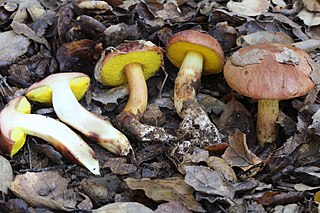
Aureoboletus is a genus of bolete fungi in the family Boletaceae. It was circumscribed by Czech mycologist Zdeněk Pouzar in 1957. A taxonomic monograph was published in 2010 by Wolfgang Klofac.

Aureoboletus mirabilis, commonly known as the admirable bolete, the bragger's bolete, and the velvet top, is an edible species of fungus in the Boletaceae mushroom family. The fruit body has several characteristics with which it may be identified: a dark reddish-brown cap; yellow to greenish-yellow pores on the undersurface of the cap; and a reddish-brown stem with long narrow reticulations. Aureoboletus mirabilis is found in coniferous forests along the Pacific Coast of North America, and in Asia. Unusual for boletes, A. mirabilis sometimes appears to fruit on the wood or woody debris of Hemlock trees, suggesting a saprobic lifestyle. Despite the occasional appearances to the contrary, Aureoboletus mirabilis is mycorrhizal, and forms a close association with the tree's roots.
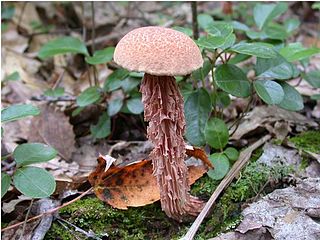
Aureoboletus russellii, commonly known as the Russell's bolete, or jagged-stemmed bolete, is a species of bolete fungus in the family Boletaceae. An edible species, it is found in Asia and eastern North America, where it grows in a mycorrhizal association with oak, hemlock, and pine trees. Fruit bodies of the fungus are characterized by their coarsely shaggy stem. The yellow-brown to reddish-brown caps are initially velvety, but become cracked into patches with age.

Tylopilus alboater, called the black velvet bolete, by some, is a bolete fungus in the family Boletaceae. The species is found in North America east of the Rocky Mountains, and in eastern Asia, including China, Japan, Taiwan, and Thailand. A mycorrhizal species, it grows solitarily, scattered, or in groups on the ground usually under deciduous trees, particularly oak, although it has been recorded from deciduous, coniferous, and mixed forests.
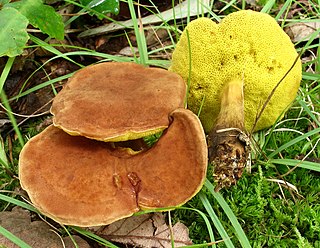
Aureoboletus innixus is a species of bolete fungus in the family Boletaceae. Found in eastern North America, it was first described scientifically by Charles Christopher Frost in 1874, from collections made in New England. An edible mushroom, the convex cap grows to 3–8 cm (1.2–3.1 in) wide and is dull reddish brown to yellow brown. The stem is 3–6 cm (1.2–2.4 in) long by 1–1.6 cm (0.4–0.6 in) thick, but often swollen at the apex with a tapered base. It has a bright yellow pore surface when young that dulls in color when mature. There are about 1 to 3 pores per mm when young, but they expand as they mature to about 2 mm wide. The spore print is olive-brown, and the spores are ellipsoid, smooth, and measure 8–11 by 3–5 um.

Aureoboletus auriflammeus, commonly known as the flaming gold bolete, is a species of bolete fungus in the family Boletaceae. Described as new to science in 1872, it is found in eastern North America, where it grows in a mycorrhizal association with oaks. The caps of the fruit bodies are golden orange, with a yellow pore surface on the underside, and a reticulated (network-like) stem. The edibility of the mushroom is not known.
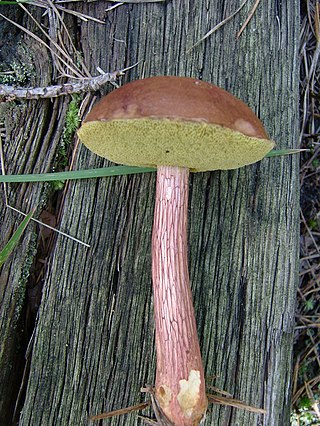
Aureoboletus projectellus is a species of bolete fungus in the family Boletaceae. Found in North America, and recently in Europe, it grows in a mycorrhizal association with pine trees.

Tylopilus badiceps is a bolete fungus in the family Boletaceae native to North America. It was described in 1900 as Boletus badiceps by Charles Horton Peck, and transferred to the genus Tylopilus in 1971 by Alexander H. Smith and Harry Delbert Thiers. It is a good edible mushroom.

Aureoboletus gentilis is a species of bolete fungus in the family Boletaceae. Originally described as Boletus sanguineus var. gentilis by French mycologist Lucien Quélet in 1884, it was transferred to the genus Aureoboletus by Zdeněk Pouzar in 1957. It is considered vulnerable in the Czech Republic.

Retiboletus ornatipes, commonly known as the ornate-stalked bolete or goldstalk, is a species of bolete fungus in the family Boletaceae. Originally named Boletus ornatipes by American mycologist Charles Horton Peck in 1878, it was transferred to Retiboletus in 2002.
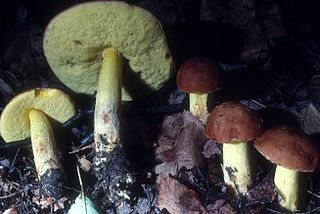
Hemileccinum subglabripes is a fungus of the family Boletaceae native to North America. It was first described by Charles Horton Peck in 1887 as Boletus subglabripes. In 2015 it was transferred to Hemileccinum based on DNA evidence.

Hydnum umbilicatum, commonly known as the depressed hedgehog, is a species of tooth fungus in the family Hydnaceae. It was scientifically described in 1902 from New York by American mycologist Charles Horton Peck. It is found in eastern North America. It is edible and good.
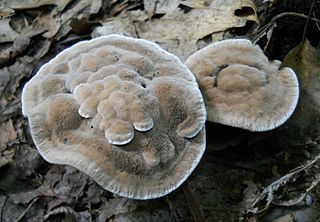
Hydnellum spongiosipes, commonly known as the velvet tooth, is a tooth fungus in the family Bankeraceae. It is found in Europe and North America. In Switzerland, it is considered a vulnerable species.

Suillus punctipes, commonly known as the spicy suillus, is a bolete fungus in the family Suillaceae.

Xanthoconium affine is an edible species of bolete fungus of the genus Xanthoconium. First described as a species of Boletus by Charles Horton Peck in 1873, it was placed in its current genus by Rolf Singer in 1944.

Aureoboletus moravicus, commonly known as the tawny bolete, is a species of bolete fungus in the family Boletaceae that is found in Europe. Originally described as Boletus moravicus by Václav Vacek in 1946, it was transferred to the genus Aureoboletus by Wolfgang Klofac in 2010. It is an uncommon bolete of unknown edibility that appears as a vulnerable species on some European Red Lists, and is considered critically endangered in the Czech Republic. Preferred habitats include parklands, near oak trees.
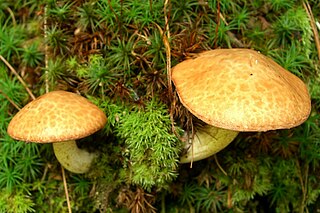
Suillus subaureus is a rare species of bolete fungus in the family Suillaceae. It is found in North America, where it associates with deciduous trees. Originally described in 1887 by Charles Horton Peck, it was transferred to genus Suillus by Wally Snell in 1944. Fruitbodies are pale yellow—reflecting its specific epithet subaureus, which means "somewhat golden yellow". The spore print is olive brown. Spores are smooth and inamyloid, and measure 7–10 by 2.7–3.5 µm. It has also been recorded in Taiwan.

Sutorius eximius, commonly known as the lilac-brown bolete, is a species of fungus in the family Boletaceae. This bolete produces fruit bodies that are dark purple to chocolate brown in color with a smooth cap, a finely scaly stipe, and a reddish-brown spore print. The tiny pores on the cap underside are chocolate to violet brown. It is widely distributed, having been recorded on North America, South America, and Asia, where it grows in a mycorrhizal relationship with both coniferous and deciduous trees.
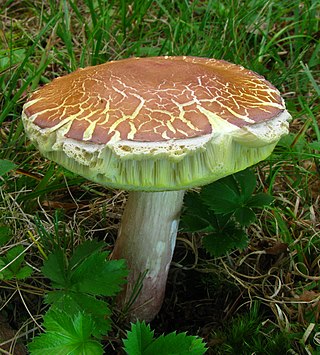
Boletus separans is a species of bolete fungus in the family Boletaceae. It was described as new to science in 1873 by American mycologist Charles Horton Peck. In 1998, Roy Halling and Ernst Both transferred the bolete to the genus Xanthoconium. Molecular phylogenetic analysis published in 2013 shows that it is more closely related to Boletussensu stricto than to Xanthoconium.
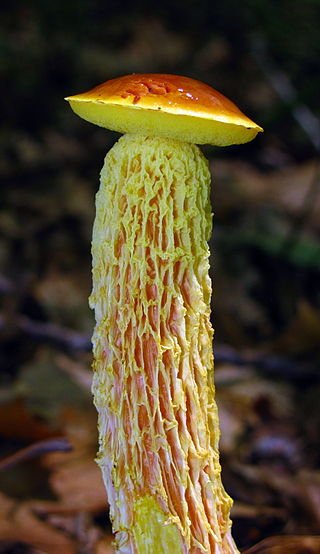
Aureoboletus betula is a species of mushroom producing fungus in the family Boletaceae. It is commonly known as the shaggy stalked bolete.




















